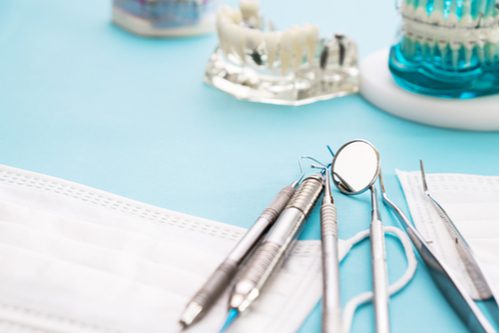Blog
3 Min Read:
Dr. Chad Tomazin is the only SMART-certified dentist in the Inland Empire, having been certified by the International Academy of Oral Medicine and Toxicology (IAOMT).

You might be asking, “What does this mean, and why does it matter to my dental and overall health?” SMART is an abbreviation of the Safe Mercury Amalgam Removal Technique, and this certification is provided by the IAOMT. As a member and practitioner in this community, Dr. Tomazin promotes mercury-free, mercury-safe, and biological/biocompatible dentistry through rigorous research, education, practice, and new techniques.
Southern California has always been a destination for forward-thinking lifestyles that encourage more natural approaches to their health and wellbeing. In step with this, it is important that SMART-certified doctors work to describe what being SMART certified means for the betterment of their communities.
What Is Safe Mercury Removal?
As the information on the harms of mercury becomes more prolific, many people are beginning to seek answers as to how to remove the harmful metal in their mouths. Still, some are nervous about where to begin, and having to go in for an additional dental treatment can seem taxing to their wallet and to their risk of developing further complications if not executed properly.
There are dangers present when removing fillings. However, patients who desire to eliminate any cause for concern should seek out a SMART-certified dentist. Safe Mercury Amalgam Removal Technique is a scientifically supported method for removing existing mercury amalgam fillings while assisting in reducing the potential negative health outcomes of mercury exposure.
How Does a Dentist Become SMART Certified?
Along with becoming a member of IAOMT, a dentist who wishes to receive SMART certification training will have completed coursework related to mercury and the dangers of mercury vapor. Additionally, two units of scientific readings, online lecture videos, and assessment tests are required. The high-level educational programming includes learning about the application of rigorous safety measures, including the utilization of specific mercury removal equipment.
Information surrounding the nature of mercury and how it behaves as it is being removed are important to maintaining a safe environment for a dentist and their patient. Factors such as room ventilation, separators, open windows, protective gowns, and covers, are all vital to providing the utmost care to their patients.
Interested in Learning More About SMART Certified Dentists?
Dr. Chad Tomazin has been proudly serving the Inland Empire community for years, bringing compassionate care and expertise to each patient’s dental needs. SMART certification is designed to envision a better future for a patient’s health. Dr. Tomazin provides his patients with professional and expert techniques to safely remove the mercury from their mouths.
If you are looking for more information on SMART and certified doctors in your area, please contact our office in Riverside, California, by calling (951) 686-3666 or by filling out our online form.
2 Minute Read:
Teeth grinding (bruxism) may not sound like an alarming concern initially. Nevertheless, failing to correct it can lead to significant issues with your oral health and a decrease in your quality of life. Thankfully, dental night guards can help stop bruxism from taking bites out of your sleep and damaging your teeth.

What Are the Symptoms and Complications of Bruxism?
One of the best ways to stop bruxism is to be aware of its signs and symptoms. Unfortunately, many people are not aware that they grind their teeth unless their sleep partner notices it or they experience dental problems. Excessive tooth grinding can cause severe damage, such as the chipping or cracking of your natural teeth, restorations, and crowns.
Additional symptoms of teeth grinding include:
- Inability to sleep or fatigue after a long night’s sleep
- Headaches and jaw aches
- Soreness in the neck, jaw, or face
If an intense amount of teeth grinding has occurred or your teeth grinding is left unchecked, your teeth may become fractured, chipped, or even loose. Adjunct disorders may also arise, such as temporomandibular joints (TMJs), which occurs when there has been an erosion of the joint. This condition can cause clicking or popping sounds and limited or stiff movements in the jaw.
How Can I Prevent Teeth Grinding?
There are many ways you can reduce your teeth grinding (including relaxation techniques and avoiding caffeine or alcohol); however, your first and most effective defense is having your dentist fit you for a night guard. Dental night guards are highly effective, as they place a barrier between your upper and lower teeth to prevent them from clenching or grinding during sleep. Naturally, avoiding damage to the teeth also prevents you from requiring additional restorative dental procedures and having to pay unnecessary expenses for the work that bruxism-related damage may cause.
With a night guard, patients can enjoy more restful and quality sleep by easing pressure on the jaw joints and teeth, which can prevent headaches and soreness from arising during or after rest.
Even though it is possible to find dental night guards at your nearest drugstore, these pre-fitted night guards are not as comfortable or safe as the ones that Dr. Tomazin provides as the store-bought ones are not molded to your particular bite.
Interested in Learning More About Teeth Grinding and Dental Nightguards?
Dr. Chad Tomazin has been proudly serving the Inland Empire community for years, bringing compassionate care and expertise to each patient’s dental needs.
If you are looking for more information on how to prevent teeth grinding (bruxism) or are looking for a comfortable and safe dental night guard, please contact our office in Riverside, California, by calling (951) 686-3666 or by filling out our online form.
3 Minute Read:
It might seem obvious that your diet and oral health are connected; however, you may not realize how interwoven they are. By having a deeper understanding of how to apply nutritional knowledge, patients can see even more significant strides in their oral health.
Nutrition guidance for dental patients is continuing to advance as oral hygienists and dentists find emerging connections between nutrition and oral health. By incorporating a stronger understanding of nutrition, patients can further prevent oral diseases, tooth erosion, infections, and cavities.
Here are some essential elements that will help you have a modern understanding of the relationship between diet, nutrition, and their impact on your oral health.
What Is the Difference Between Diet and Nutrition?
While it is important to understand that diet and nutrition can speed up or slow down the development of oral hygiene concerns, they can be easily mistaken as interchangeable factors when they are, in fact, different.

Nutrition is defined as micronutrients and macronutrients related to an organism’s dietary needs. Nutrients can include vitamins, minerals, carbohydrates, protein, and fats. Macronutrients are required in large amounts, while micronutrients are needed in small quantities.
Your diet is defined as the actual foods consumed to obtain these nutrients.
How Does Nutrition Affect Tooth Decay?
Tooth decay remains one of the most prevalent oral health concerns for both children and adults alike. The most common relationship between tooth decay and nutrition is the frequency and amount of sugary or acidic foods and drinks a patient intakes.
One example of nutrition and its relationship to tooth decay is the intake of carbohydrates that can increase the acidity of the tooth. Excessive carbohydrate intake, such as white bread, can cause demineralization and eventual tooth decay.
Meanwhile, nutrients like Vitamin D, calcium, fiber, and whole grains have been found to decrease the risk of tooth decay.
So what are some food choices that might have these helpful nutrients to lower the risk of tooth decay?
- Grain-based rice, bread, and pasta
- Vegetables and vegetable juice with no added sugar
- Beans and legumes with no added sugar
How Does Nutrition Affect Gum Disease?
Gum disease (or gingivitis) is characterized by bleeding, infected, or inflamed gum tissue. It can be related, although not necessarily caused, by dietary habits. Good nutritional habits can decrease the severity of gum disease, while bad nutritional habits can increase its severity.
For example, diets high in refined carbohydrates and sugars can decrease the healing capacity of the gums and bone, exacerbating the issues seen in gum disease.
Adequate stores of the right nutrients can have a protective effect on the gums. These proper nutrient stores can be found in:
- Omega-3 fatty acids (anti-inflammatory)
- Magnesium, calcium, iron, zinc
- Vitamin A, B, C, D, E
- Pomegranate extract and green tea (antioxidant and anti-inflammatory)
- High fruit and vegetable intake diets (anti-inflammatory)
- High fiber, low-fat diet (i.e., vegetarian)
How Does Nutrition Affect Tooth Erosion?
Tooth erosion occurs when a tooth is exposed to frequent or prolonged acid that demineralizes and erodes the tooth structure.
Alkaline basic foods or pH neutral foods can help balance the acidity of the mouth to fight tooth erosion. While are there many, some of these include:
- Kale
- Spinach
- Oregano
- Parsely
- Limes (alkaline when in contact with the body
Want to Find Out More About Nutrition and Your Oral Health?
Dr. Chad Tomazin has been proudly serving the Inland Empire community for years, bringing passionate care and expertise to each of his patient’s dental needs.
If you are looking for more information on how your diet can affect your oral hygiene or are looking for general dentistry in a comfortable and judgment-free setting, please contact our office in Riverside, California, at (951) 686-3666 or by filling out our online form.
3 Minute Read:
During pregnancy, your brain is already shooting in a million different directions. Do you have everything you need for the nursery? Is your home safe and baby-proof? How will your new bundle of joy fit into your work schedule? Are you and your partner emotionally prepared for the trials of parenthood?
With all of these concerns, it is understandable how some routine day-to-day activities can slip through the cracks. The one thing that you do not want to let slip, however, is your oral health.
How Does My Dental Health Affect My Baby?
Most expectant mothers are not aware that their oral health can affect the health and safety of their unborn babies.
Studies have shown that women who have gum disease are more likely to go into premature labor, which puts the child at higher risk due to their smaller, less-developed size. Additional studies show that children of women with untreated cavities or gingivitis are also more likely to have cavities at a younger age.
What Is Pregnancy Gingivitis?
Pregnancy gingivitis is a common affliction experienced by expectant mothers because of hormonal changes that increase blood flow in the mouth. Gingivitis is characterized by the swelling of the gums, which may be more vulnerable to bleeding and irritation.
This, too, can impact a child’s development.
What Can I Do to Protect My Smile and My Child?
While poor oral health can be detrimental, proper practices are as simple as performing good dental hygiene.
What Should I Do?
- Brush your teeth: Sometimes, the oldest adages still hold the most weight. Brushing your teeth twice a day for at least two minutes each time (30 seconds per quadrant of the mouth) can significantly help maintain your oral health by eliminating the day-to-day bacteria and plaque build-up.
- Floss your teeth: Daily flossing allows you to clean between the deepest nooks and crannies of your mouth to ensure that no bacteria is left lurking around. Pregnant women—and non-pregnant individuals as well—should floss at least once a day.
- Eat a nutritious diet: Eating a nutritious diet that is low in excess sugars helps to ensure that no excess bacteria are present in your mouth. So while it may be a challenge to resist those late-night ice cream cravings, try to limit them for your health and the health of your baby.
- Chew xylitol gum: Xylitol chewing gum is a sugar-free gum that helps to prevent tooth decay and dry mouth.
- Eat xylitol chips: If chewing gum isn’t your style, you can always try out xylitol chips, a sugar-free candy that is shown to reduce tooth decay and cavity-causing bacteria while strengthening teeth.
- Stay hydrated: Staying hydrated is essential for your health, your skin, and your teeth. Unfortunately, pregnancy often leads to dry mouth, which can result in tooth decay and infections. Drinking water will help rinse bacteria out of your mouth so that the bacteria do not fester into something worse.
- Visit Dr. Tomazin: You wouldn’t miss a prenatal check-up with your doctor. So why should you skip out on a prenatal dental visit? Visiting Dr. Tomazin for a cleaning and check-up is one of the best ways to ensure that both your baby and you remain healthy.
Interested in Learning More?
If you are interested in learning more about the importance of your oral health during pregnancy or in setting up an appointment with Dr. Tomazin, contact our offices by calling (951) 686-3666 or by filling out our online contact form.
4 Min Read
 We all desire to achieve a beautiful, white smile that can be spotted from across the room. The cornerstone of that great grin is a mouth full of healthy teeth.
We all desire to achieve a beautiful, white smile that can be spotted from across the room. The cornerstone of that great grin is a mouth full of healthy teeth.
Unfortunately, as far too many men and women know, that dream-worthy smile can be challenging to achieve.
So, how do you attain that noteworthy set of teeth?
The first step to realizing (and maintaining) the smile of your dreams is to eliminate any tooth decay that may have developed and stop new tooth decay from forming.
Prevention is the most practical and cost-effective way to realize your optimal dental health.
What Causes Tooth Decay?
Tooth decay, which is more commonly referred to as cavities or dental caries, is one of the most significant threats to the functional and cosmetic health of your teeth.
Tooth decay develops when plaque (from bacteria) sticks to the surface of your teeth and is not promptly removed. Like gum disease, tooth decay results from bacterial infections, poor nutrition, and subpar oral hygiene.
The good news is that teeth decay is entirely preventable.
How Can I Prevent Tooth Decay at Home?
1. Brush Your Teeth Twice a Day
Your very first lesson in oral hygiene was probably the importance of brushing your teeth. The benefits of this practice are just as real now as when you were a kid.
Whether you are using an Oral-B® Genius electric toothbrush or a good ol’ manual toothbrush, religious brushing practices are your first and most reliable defense against the bacteria that leads to plaque and subsequent tooth decay.
By brushing twice a day (preferably after meals), you can dislodge and eliminate bacteria from getting stuck and festering on the tooth surface.
2. Floss Every Day
While brushing is the essential at-home dental hygiene practice, flossing comes in at a close second. Flossing reaches the nooks and crannies between your teeth that a brush cannot, and it rids your mouth of even more potentially harmful plaque deposits.
Ideally, you should clean between your teeth at least once a day with traditional floss, interdental cleaners, or water flossers (such as the Waterpik®).
3. Avoid Excess Sugars
Avoiding excess sugars goes beyond skipping that caramel-filling candy at the movie theaters and that extra slice of chocolate cake at dessert.
Proper nutrition is essential to your oral health. Eating a balanced diet and limiting unhealthy snacking will help to limit tooth decay by lessening the amount of harmful sugars in your mouth.
And like anything, moderation is key. No one can or will say no to sweet indulgences all of the time—nor should you. The key is to make sure you take care of your teeth as well.
4. Stay Hydrated
Water will keep you (and the lining of your mouth) hydrated and will help rinse food particles out of your mouth to prevent bacteria from forming between your teeth and in the crevices of your mouth.
Sipping sugary beverages—such as juice, sports drinks, and soda—does not do you any favors either. Not only do these options not hydrate you, but they are full of empty calories and excess sugars that cling to your teeth and get right to work breaking down your enamel.
5. Visit Dr. Tomazin Regularly
Even the most diligent at-home dental practices can suffer when they are not paired with regularly scheduled dental exams and cleanings. A deep cleaning at your dentist’s office is no ordinary clean. It delves much deeper than what is possible at home and targets the bacteria and plaque that brushing and flossing leave behind.
By visiting your dentist twice a year, you can feel confident that any tooth decay that manages to develop will be handled quickly and correctly. This helps to prevent unwanted dental pain, functional concerns, cosmetic worries, and unexpected dental costs.
Why Should I Choose Dr. Chad Tomazin?
Dr. Chad Tomazin offers general and cosmetic dentistry services for patients in the Inland Empire. He is SMART certified (for the safe removal of mercury fillings) and a believer and practitioner of biological dentistry, a non-universally practiced concept in dentistry that strives to put the patient’s overall health above all else. Dr. Tomazin seeks out and applies treatments and practices that create the least toxicity and potential harm to your health.
With Dr. Tomazin, you can rest assured that you are not only going to maintain (or achieve) a healthy smile, but you can also accomplish that smile with the least amount of threat to your overall health.
Interested in Learning More?
If you would like to learn more about at-home tips for a healthy mouth, contact Dr. Chad Tomazin by calling (951) 686-3666 or by filling out our online contact form.




 We all desire to achieve a beautiful, white smile that can be spotted from across the room. The cornerstone of that great grin is a mouth
We all desire to achieve a beautiful, white smile that can be spotted from across the room. The cornerstone of that great grin is a mouth